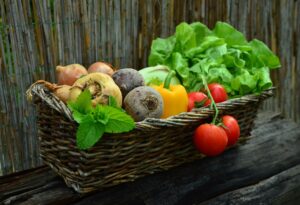To wash vegetables, follow these steps:
- Rinse the vegetables under cold running water. This helps to remove any dirt or debris.
- Use a vegetable brush to scrub the vegetables. This helps to remove any dirt or pests that might be hiding on the surface of the vegetables.
- Place the vegetables in a colander or strainer and rinse them again under cold running water.
- Dry the vegetables thoroughly with a clean towel or paper towels.
It is generally a good idea to wash vegetables before cutting them,
as this helps to remove any dirt or contaminants that may be present on the surface. Once vegetables are cut, bacteria and other contaminants that may be present on the surface can be transferred to the inside of the vegetable, where they may be more difficult to remove. Additionally, cutting vegetables can create small nooks and crannies on the surface of the vegetable that can harbor bacteria, so it is especially important to wash them before cutting.
If you do need to wash vegetables after cutting them, be sure to dry them thoroughly to help reduce the risk of bacterial growth. It is also a good idea to use a clean cutting board, knife, and other utensils to minimize the risk of cross-contamination.
It is important to wash vegetables before eating or cooking them to remove any dirt, bacteria, or pesticides that may be present. Washing your hands before handling the vegetables and using clean utensils and cutting boards can also help to reduce the risk of foodborne illness.
We all love vegetables. There’s nobody who hates it. It is a gift of nature that helps our body to be healthy and disease-free. We know that vegetables contain lots of vitamins. Green vegetables contain vitamin A, the deficiency of which can cause blindness at night. Vitamin B deficiency causes beriberi and infection in your mouth. It also helps to keep your nerves healthy and make your platelets. Vitamin C helps to keep your gums and skin healthy. Vitamin E is known to prevent heart diseases.
As vegetables are a good source of vitamins, let’s know how it should be cooked. Washing the vegetables after cutting is a bad way to cook. You have to wash vegetables before cutting. Don’t chop vegetables into very small pieces and leave them under open air for a long time. Don’t wash the vegetables after boiling either. In this way, the necessary vitamins are washed away, which decreases the nutritional value of vegetables. Boil the vegetables with little water. Then cook it with a little oil under a bit of heat. That way, you can get the best out of it.
How to Wash Your Leafy Vegetables:
Leafy vegetables such as lettuce, kale, spinach, and arugula are packed with essential vitamins, minerals, and fiber that are beneficial for your health. However, they can also be a breeding ground for harmful bacteria such as E. coli, salmonella, and listeria. That’s why it’s important to wash your leafy vegetables thoroughly before consuming them. In this section, we’ll discuss the key steps to follow when washing your leafy greens.
-
Start with clean hands
Before you begin washing your leafy vegetables, it’s essential to wash your hands thoroughly with soap and warm water. This will help remove any bacteria or germs on your hands that could be transferred to your greens during the washing process.
-
Rinse your vegetables with cold water
To start the washing process, place your leafy vegetables in a colander or strainer and rinse them under cold running water. Be sure to remove any damaged or wilted leaves and discard them.
-
Soak your vegetables in a bowl of cold water
After rinsing your vegetables, fill a large bowl or basin with cold water and place your greens in the bowl. Make sure the water covers the vegetables completely. Swirl the vegetables around in the water for a few seconds to loosen any dirt or debris that may be stuck to them.
-
Remove any remaining dirt
If you notice any remaining dirt or debris on your vegetables after soaking them, gently rub the leaves together under running water. This will help remove any dirt or debris that may be stuck to them.
-
Dry your vegetables
Once you have finished washing your leafy vegetables, gently shake off any excess water and dry them with a clean kitchen towel or a salad spinner. Drying your vegetables is important because excess water can promote bacterial growth.
-
Store your vegetables properly
After washing and drying your leafy vegetables, it’s essential to store them properly to prevent bacterial growth. Place your greens in a clean and dry container or plastic bag and store them in the refrigerator. Make sure to use your vegetables within a few days to ensure their freshness and nutritional value.
In conclusion, washing your leafy vegetables is a simple but essential step in maintaining your health and preventing the spread of harmful bacteria. By following these key steps, you can ensure that your leafy greens are clean, fresh, and safe to consume.

